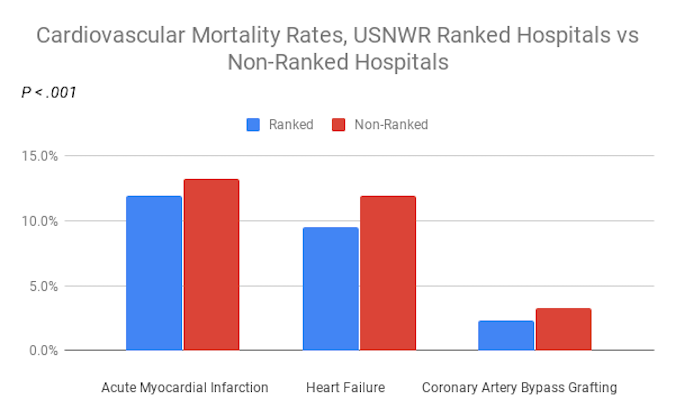US News & World Report Hospital Rankings Reliable for Cardiovascular Outcomes
A new study found the annual top-50 ranking is a reliable indicator of cardiovascular disease mortality and patient satisfaction.

Deepak L. Bhatt, MD, MPH
In the experiences of Deepak L. Bhatt, MD, MPH, there’s not a single hospital that doesn’t care about the annual US News & World Report ranking of healthcare facilities.
“Some like to pretend they don’t care about it,” Bhatt, executive director of Interventional Cardiovascular Programs at Brigham and Women’s Hospital Heart & Vascular Center and professor of medicine at Harvard Medical School, told MD Magazine®. “But the reality is every hospital is paying attention to it, and the best hospitals in the country are devoting resources to trying to improve their rankings.”
It’s a relief to know those resources are not being wasted. A new national retrospective cross-sectional study from Bhatt, David E. Wang, MD, and Rishi K. Wadhera, MD, MPP, found that the hospitals chosen by the US News & World Report (USNWR) to represent the nation’s best in cardiology and heart surgery may actually be just that.
Using hospital-level risk-standardized 30-day mortality and readmission rates for acute myocardial infarction (AMI), heart failure (HF), and coronary artery bypass grafting (CABG), the team assessed true patient outcomes among hospitals ranked in the top 50 of the USNWR 2018-2019 “Best Hospitals” for “Cardiology and Heart Surgery” list—in comparison to 3502 non-ranked hospitals.
The investigators also assessed the quality of the annual top 50 ranking itself: USNWR’s selected hospitals were divided into quintiles based on their rank (i.e. 1-10; 11-20; 21-30; 31-40; 41-50), to compare outcome measures among quintiles and see if a higher ranking was truly associated with better patient outcomes.
What the team was looking for, Bhatt explained, was whether this coveted award is simply a “badge of prestige” or “something of substance.” Results indicated the latter.
In assessing for 30-day mortality rates, investigators found the mean AMI (11.9% vs 13.2%; P < .001), HF (9.5% vs 11.9%; P < .001), and CABG (2.3% vs 3.3%; P < .001) were lower for the 50 top-ranked hospitals than for non-ranked hospitals.

For 30-day readmission rates, the 2 hospital groups were comparable in AMI (16.7% vs 16.5%; P = .64) and CABG (14.1% vs 13.7%; P = .15), but higher for HF (21.0% vs 19.2%; P < .001) among the 50 ranked hospitals.
That said, Bhatt argued that gauging cardiovascular-based care on metrics surrounding readmission rates or even HF may not be reliable—he noted how US hospitals face monetary penalization for HF readmissions, despite there being evidenced associations between such a penalizing program and higher mortality among patients with HF.
“Here, too, we find that hospital readmissions for heart failure really just aren’t a good metric,” Bhatt said.
In comparing higher-ranked versus lower-ranked hospitals among the 5 quintiles, investigators found little difference among the 3 cardiovascular conditions. However, patient satisfaction, as per the Hospital Consumer Assessment of Healthcare Providers and Systems (HCAHPS), fared better for the top-ranked quintile hospitals versus the lowest-ranked (4.2 vs 3.8; P = .01).
According to the study, the USNWR rankings are partially (37.5%) dependent on raw mortality data obtained from the Center for Medicare Services (CMS), while readmission rates remain varied across patients with differing cardiovascular conditions. Investigators concluded the uncertainty surrounding readmission rates’ value in cardiovascular care needs to be continually assessed.
In the meantime, USNWR’s rankings has been confirmed as a worthwhile barometer for critical cardiovascular disease patient outcomes. Bhatt noted the large rate and variation of healthcare trade publication rankings available to patients—believing their merit should all be investigated. At least USNWR’s annual ranking gives a good representation of “outcomes that matter to patients.”
“Why not go to a hospital where you’re more likely to survive, and you’re more likely to be satisfied?” Bhatt said. “It’s a pretty good combination.”
The study, "Association of Rankings With Cardiovascular Outcomes at Top-Ranked Hospitals vs Nonranked Hospitals in the United States," was published online in JAMA Cardiology.